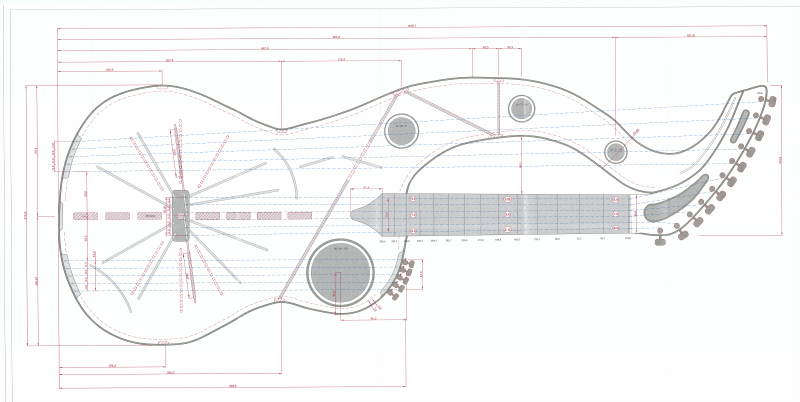12 Harp guitar
Introduction
To start with: A harp guitar is a guitar with some extra strings that are not fretted. Instruments that fulfill that definition are numerous and of all times. But well proven designs that are built in large quantities are rare. In that view three different designs are important:
"Schrammel gitarre"
The contra guitar or Schrammel guitar is a type of guitar developed in Vienna in the mid-nineteenth century. Called after the two brothers Schrammel who made this type of music popular in the 19th century. In addition to the usual guitar neck with six strings and a fret board, it has a second, fretless neck with up to nine bass strings. To withstand the enormous pull of the strings on the body, there is a steel pin inside.
Knutsen harp guitars
Chris Knutsen, is named to be the father of the American harp guitar. Knutsen was granted a patent in 1897 for a "one-arm harp-guitar". This style had a hollow extension of the body holding the 5 to 7 harp strings. The other major harp guitar makers were W.J. Dyer and Brothers. The Dyer-Knutsen contract started in 1899, with Chris Knutsen to supply Dyer with his harp guitars for sale in the Mid-west and the East. Knutsen made a lot of interesting instruments and no two were alike. This may be why Dyer contacted the Larson Brothers of Chicago to build their harp guitars. Production numbers for these instrument are unknown, but based on the serial numbers it is estimated between 500 and 600.
Gibson harp guitar
The Gibson Harp Guitar is one of the most fanciful looking instruments the Gibson Company (or any other company) ever made. It debuted in the year 1902 in four different versions .The number of sub-bass strings ranged from 6 to 12. As with all Gibsons at the time, these instruments were arch tops. The style-U was the largest, 122 cm long and 53 cm wide. With strong marketing and financing available, they were able to sell more than 500 harp guitars.
Schrammel guitar | Knutsen harp guitar | Gibson harp guitar |
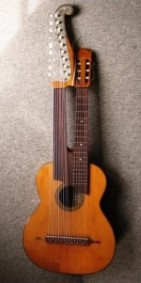 |
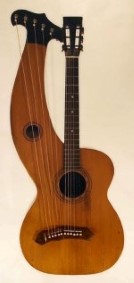 |
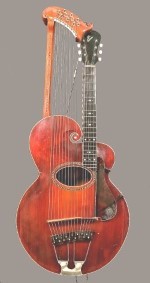 |
More and detailed information on harp guitars can be found on harpguitars.net.
General layout
The sound of a harp guitar is characterized by a:
- large volume
- large sustain
- large reach (extra octave)
- resonance of the open strings
Strengthening these features leads to the choice of an hollow arm concept and to the addition of a treble bank.
In the design of a classical guitar the strength of the top is a critical issue. A large sound volume asks for a thin top. The pulling forces of the (6) strings has to be compensated by a smart choice (number, position, dimension) of the construction and sound bars. An insufficient balance between the strength and acoustical performance can lead to failures like ruptures of the top, release of the glue connection with the bridge et cetera.
By adding extra strings, as in the case of the harp guitar, (especially when the thick sub-bass strings are connected to the guitar bridge) the pulling forces on the bridge are more than doubled. Compensating this effect by increasing the thickness of the top and/or the number or height of the bars will negative influence the mentioned specific features of a harp guitar.
To counterbalance these negative effects the following choices are made:
The bass strings as well as the treble strings are passed over separates saddles and connected to small bridges attached to the side/top ridge (as in the case of a violin or cello).
In this way the extra forces of the harp strings pull mainly on the sides of the guitar which can easily be protected from deformation. In the design of the EB-2015 harp guitar these forces are dealt with with a long construction bar running from the heel to the two bridges for the bass bank and treble bank. Of course this Υ-shaped construction bar (Y-bar) is not glued to the top or the back.
Image: Y construction bar

The sound hole is positioned in the upper right corner of the sound-box.
The traditional central placed sound hole in classical guitars creates a weak spot in the most highly-stressed parts of the top. To compensate, traditional designs are heavily braced around the sound hole, which stiffens the entire top at the cost of responsiveness and bass. This is just a fact of life unless you move the hole.
By placing the hole in the upper bout area, the top does not lose this critical structural integrity, and can thus be braced more lightly and tuned for greater response and low-end extension.
The offset location also creates a larger area of unbroken top surface, which can act as a larger and more effective vibrating plate.
Construction and sound bars are positioned to support the top in view of strength as well as acoustical qualities.
-
The choice for a hollow arm concept offers an extra advantage when the hollow arm is immovably fixed to the neck of the guitar. The inherent strength of a case-construction gives the possibility to use a slender neck, optimized in view of playability.
For the harp guitar the classical guitar as described on this website is used for the "guitar part". So the scale length is 648 mm and the distance length of the neck (distance between the 0-fret and the 12th fret) is 324 mm. Taken into account the room needed to locate the two extra bridges for the bass and treble strings the width of the lower bout has to be increased compared to the classical guitar (379.9 instead of 368 mm). Combined with the layout of the head the contour of the harp guitar is almost fixed. Fluent lines running from the sound box to the head finalize the contour of the instrument.
Image: General layout of the harp guitar

The neck and head
As explained before the choice is made for an "integrated head". This is for two reasons.
The first reason is that the construction with a hollow arm, immovably fixed to the neck of the guitar, is much stronger than a construction where the two are more or less separated. The case-construction of the hollow arm is in itself rigid and gives more resistance to bowing than the guitar neck. This means that the guitar neck can be relatively thin without specific strengthening with for example thrust rods.
The second reason is that for most people a "one piece" headstock is visually more attractive than two more or less separated headstocks.
There are a lot of ways to position the tuning mechanisms. One of the puzzles you have to solve in the construction of a harp guitar is the positioning of the tuning mechanisms on the head. The distances between the strings are fixed based on the playability. For the EB-2015 harp guitar the following distances are chosen.
| Which strings | At level of guitar bridge | At level of nut |
|---|---|---|
| Treble | 11 mm (constant) | N/A |
| Guitar | 11 mm (at the bridge) | 8 mm |
| Bass | 11 mm | 20 mm |
It is clear that there is not much room to put the tuning mechanism at a row without hampering the tuning itself. The solution can be found by:
- using specific small tuners,
- positioning the tuners not in a row, or
- a combination of these.
For the treble bank of the EB-2015 harp guitar I have used banjo tuning pegs for the 5th string.
Image: Harp guitar head | Image: Harp guitar treble tuners |
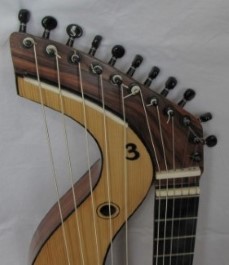 |
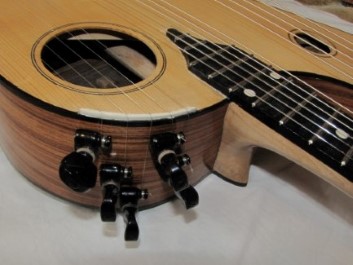 |
My advice: make sketches, make models, have fun and come to your own design.
The bridge(s)
In general harp guitars have a bridge glued to the top. The extra bass strings or treble strings are attached to the same bridge. This was the case with the "Schrammel gitarre" and with the harp guitars following the Knutsen design. A clear disadvantage of this approach is that the design has to cope with the extra pulling forces on the top. This was done by:
- thickening the top
- adding extra construction bars
- or enforcing existing construction bars.
In the design as described on this website the fretted strings from the guitar are connected with a more or less standard "guitar bridge" whereas the unfretted bass strings and treble strings are guided over two floating bridges and connected to tailpieces fixed to the back. The aim of this approach is to keep the more complex (higher) harmonics and sustain of the fixed bridge and introduce a fast and clear response of the trebles and basses.
Image: From ox shin to saddle
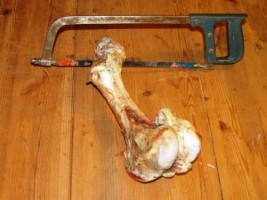
All bridges and saddles should be made of hard inflexible material. For the EB-2015 harp guitar the choice is made for ebony or bone. Commercially available nuts or saddles are in general too short and not bent, so for use in the bass and treble banks you have to make those yourself.
For the bass and treble banks decisions on the position and height of the saddles have to be made. The layout of these saddles is based on the well known look of the saddles as used for violins, cello's or (contra) basses. The length has to be conform the width of the bass-bank or treble-bank. That means for the EB-2015 harp guitar 4 x 14 ~ 52 mm for the bass saddle and 4 x 11 ~44 mm for the treble saddle. They have to be positioned straight underneath the strings and as much as possible in the middle of the free vibrating surface of the top. In fact there are arguments for two different options.
The optimum choice depends on a lot of variables related to the design of the top. Such as thickness, sound bars, strings and tuning. Do not worry, these saddles are not glued to the top and may be moved in and between both positions to find out which position gives the best result or the result you like most.
The decision on the height of the saddles is more complicated. Increasing the height gives more pressure and a larger volume. Too high brings the risk the saddle will be pulled over. A saddle too low decreases the string-angle and so decreases the sound volume. In parallel with the experience in the violin family the string-angle should be between 10 and 20 degrees. For the EB-2015 harp guitar several bridges with different heights and in different positions were tested.
Image: Test of the position and heights of the bass and treble bridges

The soundboard
As in the case of a classical guitar the sound of a harp guitar is mainly defined by the characteristics of the top. Decisions on the construction of the top, in chronological order, are:
- 1. materials
- 2. dimensions
- 3. sound holes
- 4. construction bars and sound bars
- 5. dome of the top
- 6. thickness of the top
In general spruce is the first choice for the top. There are many suppliers who sell guitar tops that are suitable for a classical guitar, so sized ~500 x 20 x 5 mm. For a harp guitar the possibilities are more restricted. You have to look for a supplier who sells tops for cello or bass to become a one-piece top with a length of 90 to 100 cm. High quality sound wood is rather expensive. But if you go for a piece with failures in the upper/right part (the part that you don’t need for a left- handed harp guitar) you can save a lot of money. There are a few providers that sell specific tops for harp guitars.
As a parallel to the main cross bar in a classical guitar the harp guitar has to be provided with a long strong diagonal transverse bar connecting the two opposite sides. This bar is positioned to pass close to the first and second sound holes to strengthen those weak parts. The main transverse bar on the back is placed at almost the same position. The main function of the transverse bars is to connect opposite sides. From that point of view there is no need to glue those bars to the top all the way. In the top of the hollow arm it is important not to introduce a fixed barrier for the sound waves. So the longitudinal transition bar is interrupted with a cut-out arch over a distance of 4 to 5 cm. So in general: the boundary of the acoustic top is formed by the sides and the main transverse bar extended to the hollow arm top by the gateways in the transverse bar.
The design of the sound bars of the top are similar to the design of the classical guitar. See chapter The soundboard.
Image: EB-2015 harp guitar inside

The main sound hole is located in the upper right corner of the upper bout. The inner diameter is taken as 80 mm, based on the same arguments as were valid for the classical guitar. As you can see from the image "Harp guitar inside" three more "sound holes" are projected in the top of the hollow arm. The position of the first one is located in such a way that the main soundboard is left unattached but still in reach of the (1.2) and (3.1) modes. So this opening will enforce the air driving pumping for the frequencies in regard to those modes (see the discussion in chapter The soundboard). The inner diameter has to be large enough to support the pumping function but small enough to let the sound waves in the top pass to the next part of the hollow arm. The third small "sound hole" has only a very small acoustical function and location and size are mainly based on visual arguments.
Strings and tuning
For harp guitars, Knutsen himself states that the bass strings for his Symphony harp guitars were to be tuned G, A, B, C, D (low to high – highest next to guitar neck). This tuning was also my first choice for the EB-2015 harp guitar.
Which tuning you use for your own harp guitar depends on:
- The number of sub bass strings
- The available strings, suited for the string length
- The kind of music you intend to play
Video: Sound of treble strings
It is advised to be well informed on the available strings for your design. For example most string sets for harp guitars are intended for harp guitars were the sub bass strings (and if relevant the treble strings) are directly connected to the guitar bridge. If you use floating bridges for the bass and treble banks as is the case with the EB-2015 harp guitar you need strings with an extra length (~15 cm).
Information on treble string bank tuning is hardly available. Use plain steel strings to get high pitch (up to 660 Hz or above).
Final remarks
A 16 strings harp guitar looks, compared with a standard classical guitar, exceptional. But also a little bit clumsy to handle and heavy as well. The EB-2015 harp guitar as described on this website weighs approximately 3.000 grams. This is almost twice the weight of a classic guitar. This is partly due to the extra wood involved, but also due to the tuners of the harp strings (300 grams extra). It will not be easy to decrease this mass substantially. Using wooden pegs for the tuners is possible but the gain will be limited to 200 to 300 grams.
But why worry about these relative disadvantages? While you can enjoy the look and sound of a wonderful instrument!
Image: EB-2015 harp guitar front | Image: EB-2015 harp guitar back |
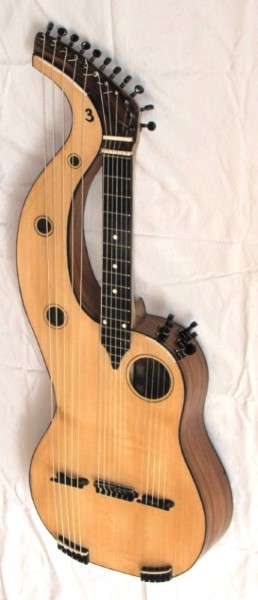 | 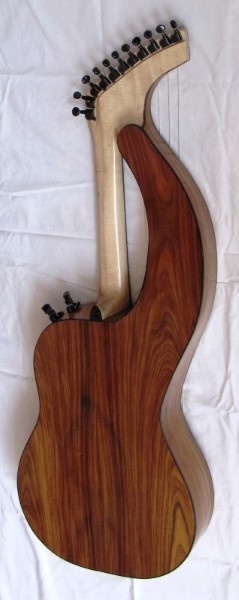 |
EB-2015 harp guitar plan
Below you see the detailed construction plan for the EB-2015 harp guitar. Click on the image to go to Building plans. From there, you can download a larger plan with better detail.
EB-2015 harp guitar impression
Are you interested in the look and sound of the EB-2015 harp guitar? The video below gives a short impression.

